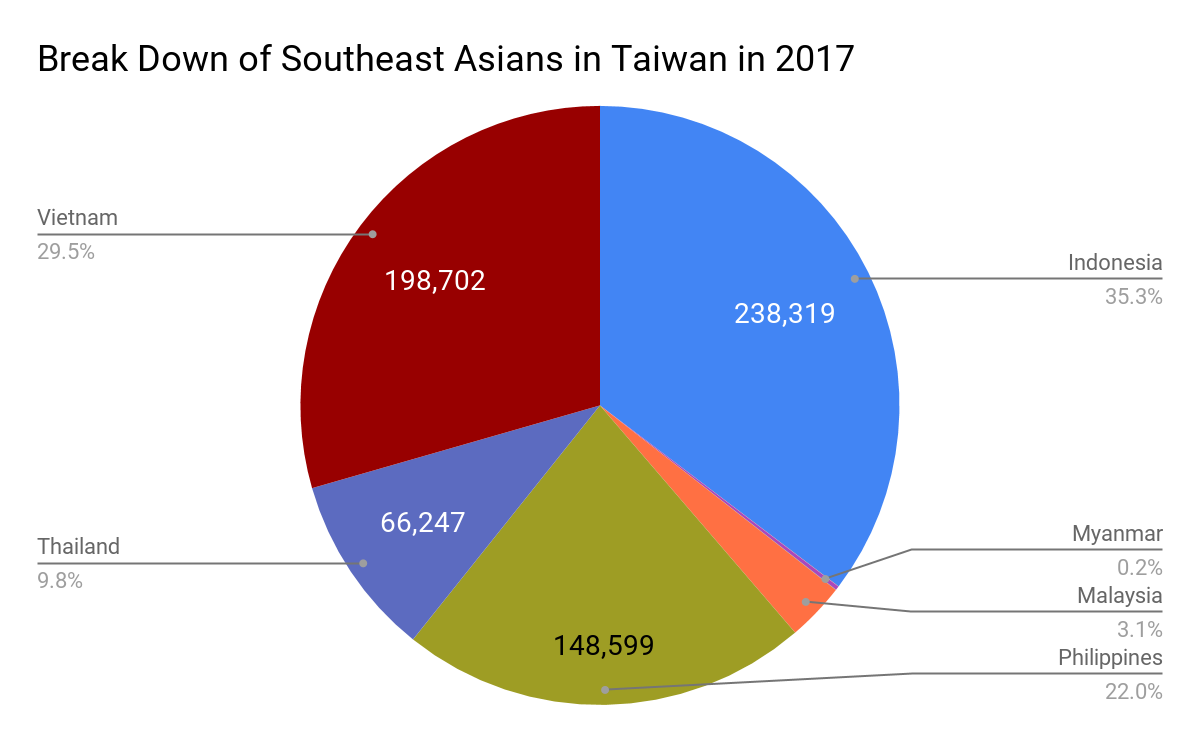Well, here is another look at demographics in Taiwan for foreign nationals, dealing with Southeast Asians.
The majority of foreign nationals in Taiwan are unsurprisingly Southeast Asians, with most of them coming from Indonesia, Malaysia, the Philippines, Thailand and Vietnam.
Southeast Asians: Form the Majority of Foreign Nationals
They form 93.3% (674,626) of the total foreign national population, while other foreign nationals with pretty much every other nationality, only make up 6.7% (48,711).
【EDIT: The total number of foreign nationals is actually 49,689 (roughly 7%)]

Breakdown of Southeast Asian demographics
When broken down further, the demographics show that the largest population of Southeast Asians were Indonesian (35.3%), Vietnamese (29.5%), Filipino (22%) and Thai (9.8%).

Minor Gender Imbalance
Compared to European demographics in 2017, which saw a gender difference of 73% male and 27% female, Southeast Asians show the opposite trend.

Taking only the largest demographics of Southeast Asians into account – with a total population of 673,036 – the breakdown of the demographics show that there are:
| Southeast Asia | Men | Women |
| Indonesia | 60,907 (25.5%) | 177,412 (74.5%) |
| Malaysia | 10,894 (51.4%) | 10,275 (48.6%) |
| Philippines | 56,069 (37.7%) | 92,530 (62.3%) |
| Thailand | 52,312 (78.9%) | 13,935 (21.1%) |
| Vietnam | 117,463 (59.1%) | 81,239 (40.9%) |
| Total: | 297,645 (44.2%) | 375,391 (55.8%) |

Gender Imbalance Explained
Whilst Europeans in Taiwan are imbalanced towards male demographics, the Southeast Asian demographics lean towards female. This can be explained by the Ministry of Labors monthly bulletin reports from 2017, which states that 247,960 female Southeast Asians, work as nurses, caregivers or domestic workers, depending on how you define their work.
In an interview with Jing Ru from the Taiwan International Workers’ Assocation, she said that:
“According to some NGOs research, they said that 60% of the elderly are being taken care of by their family, 30% are by migrant caretakers. So, these migrant caretakers, together with family members are suffering a lot.”
These female migrant workers are filling in the gap for elder care that the government fails to provide through social welfare, and this is why the Southeast Asian population is is 11.6% more female, than male.【
If you found this blog post interesting, make sure to drop on over to the Facebook page for Nihao’s It Going? and drop us a like.
